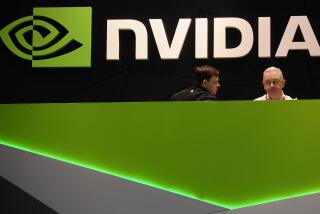Riding the Cycle in Chip-Equipment Stocks
Semiconductor-equipment makers’ stocks, on a plateau since February, got a second wind this month as chip titan Intel made two important manufacturing announcements.
On June 9, Intel introduced notebook computer chips with the tiniest circuitry yet. A few days later, the company revealed plans to use larger silicon wafers to produce its microprocessors. Together the moves will require a thorough retooling of its factories.
Intel’s initiatives add to the stream of news reminding investors that the expensive, complex machines needed to make silicon chips more powerful--and their production more efficient--are key components of the technological revolution.
In fact, a new cycle of revenue growth for the semiconductor-equipment industry has been underway since the bust of last fall, when chip makers virtually stopped buying equipment. Now they’re making up for it, boosting the fortunes of leading companies such as Applied Materials, Teradyne and KLA-Tencor.
Analysts expect this upswing to last two to three years, driven by chip makers’ needs to keep up with the technology curve and by rocketing demand for specialized chips consumed by the burgeoning communications business.
But even with these potent fundamentals, seasoned investors in chip-gear stocks know that at some point the cycle will end and these volatile stocks will crash again. As chip makers rush to expand when new opportunities beckon, they plant the seeds of the overcapacity that pulverizes prices.
Nowhere has that been truer than in the memory chip business, in which producers such as Micron Technology are still losing money.
And industry forecasts are notoriously unreliable. Even though chip unit sales have risen persistently, falling prices have shrunk industry revenue. In 1995, researcher Dataquest projected worldwide semiconductor sales would more than double by 2000, from $144 billion to $331 billion. But 1998 sales amounted to only $125.6 billion as chip makers were blindsided by the corrosive PC price war and Asia’s economic collapse.
The troubles of the last few years put the chip-equipment stocks in the bargain basement by last fall. But the fire sale is over: Shares of Applied, Teradyne and KLA have tripled off their October lows.
High optimism is a warning sign to Carl Johnson, president of Infrastructure, a Dallas consulting firm that analyzes investment trends in the sector. Nevertheless, he remains generally bullish.
“This year there has been pent-up demand, so we may indeed see a two-to-three-year recovery in orders,” he says. “But at the beginning of the cycle, you tend to use the most optimistic assumptions, and then unforeseen problems can throw out your price targets.”
The chip-equipment group as a whole has climbed about 120% since September, as measured by a stock index assembled by Semiconductor Equipment and Materials International, or SEMI, an industry group in Mountain View, Calif.
That gain sounds heady, but if history is any guide, these explosive stocks may have far to go. During the mega-cycle of 1994-96, the value of the index rocketed from 17 to 263--or more than fifteenfold--in 26 months.
The larger, best-known names are sure to stay buoyant if spending holds up. For what it’s worth, SEMI expects industry sales to grow 59%--from $22 billion to $35 billion--between 1998 and 2001.
Applied Materials is the industry’s only one-stop shop. Among its strengths are its formidable technology, its global reach and, for institutional investors, its large stock float (375 million shares outstanding).
KLA-Tencor dominates the market for chip diagnostic and monitoring systems, which become ever more essential as shrinking circuitry pushes the limits of physics.
Teradyne specializes in machines that test chips that go into networking and communications gear, while having limited exposure to memory chips.
But after the giants’ stock gains, investors might find the most leverage in the lesser-known, typically smaller firms at the center of the current technology transition.
“The companies you want to focus on are those involved in the sweetest spot of the trend, like the optical technology” that multiplies the electronic pathways on a chip, advises analyst Jay Deahna of Morgan Stanley Dean Witter.
Many companies along the food chain in this segment, called photolithography, have orders booked well into next year, says Dan Hutcheson, president of VLSI Research in San Jose.
The fastest-growing photolitho firm is ASM Lithography. ASM has been stealing business all around, especially from its big Japanese rivals, Nikon and Canon.
As is the case with many equipment firms, ASM’s fiscal 2000 earnings are expected to dwarf those of 1999: $1.77 a share, versus 43 cents, according to analysts’ consensus estimates compiled by Zacks Investment Research.
Another stock with great potential is Cymer. Its deep-ultraviolet lasers are a critical component of the new lithography machines, and it’s got the market sewn up. “Cymer is in position A,” says Johnson of Infrastructure.
Deahna expects prices for Cymer’s gear to rise during the next two years along with unit volume. He forecasts earnings of 12 cents a share in calendar 1999, leaping to at least $1.25 in 2000, and rates the stock a “strong buy” despite the distance it has traveled from its 52-week low of $5.88.
The optical opportunity extends to the makers of so-called photomasks, which transfer circuit patterns onto silicon wafers. Deahna and Johnson like both of the major players, DuPont Photomasks and Photronics, along with Etec, whose devices generate those patterns.
Other areas of the chip-equipment business are also revving up. Analyst Brett Hodess of Banc of America Securities recommends MKS Instruments, a low-profile firm that recently went public. It supplies Applied Materials and Novellus Systems with tools to measure gases used in chip fabrication.
Another favorite, Electro Scientific Industries, is in high-margin niches such as lasers for chip repair and machine-vision systems for quality control.
Both MKS and Electro were solidly in the black last quarter and are expected to show dramatic earnings growth through 2000.
Of course, the question becomes how much of that growth is already priced into the stocks. The good news is that many are off their recent highs. Cymer is down 22% from its 1999 high of $29.75; Electro is off 14% from its peak.
Still, there’s plenty of risk to balance great expectations. The glut in memory chips could refuse to improve. A global recession could wilt vibrant markets like the Internet build-out and wireless communications. Chip-making efficiency could advance so quickly that fewer machines are needed.
The indicators of changes in demand are out there for those willing to dig. Most important are data on bookings, chip-factory capacity use and the time it takes equipment makers to fill orders--longer means higher demand. SEMI (https://www.semi.org) and Infrastructure (https://www.infras.com) track some of this data.
It’s important to remember how extreme the chip-equipment cycle can be. Many investors who placed their bets when it looked as if the stocks just couldn’t get any lower have found that they can indeed.
But when the chip factories start humming, the upside in their suppliers’ stocks can be dramatic. Says Johnson, “This is a business in which revenue can jump 100% in six months.”
*
Times staff writer Edward Silver can be reached at [email protected].
(BEGIN TEXT OF INFOBOX / INFOGRAPHIC)
The Good Times Return
Chip-equipment stocks are enjoying an upswing in 1999 after their prices collapsed in 1998. Many have surged on expectations of strong earnings growth in the next two to three years. Below are some of the industry leaders, along with smaller companies in key segments. Shown are the stocks’ gains year to date and analysts’ consensus earnings per share (EPS) estimates for 1999 and 2000.
*--*
Ticker Monday ’99 YTD Est. EPS* Company symbol close % gain ’99 ’00 ASM Lithography ASML $54.69 +79% $0.43 $1.77 Cymer CYMI 23.19 +59 0.04 1.02 Applied Materials AMAT 66.38 +56 1.52 2.61 Teradyne TER 65.88 +56 1.75 2.74 KLA-Tencor KLAC 60.00 +38 0.70 1.65 MKS Instruments MKSI 19.00 +36** 0.48 0.79 Novellus Systems NVLS 61.75 +25 1.55 2.98 DuPont Photomasks DPMI 44.00 +4 1.04 1.79 Photronics PLAB 23.63 -1 0.52 1.10 Electro Scientific ESIO 41.40 -9 0.82 1.98 Etec ETEC 32.56 -19 0.45 0.77 S&P; 500 index 1,331.35 +8
*--*
*Estimated earnings per share
**Gain since initial offering March 30
Sources: Bloomberg News, Zacks Investment Research






